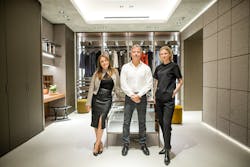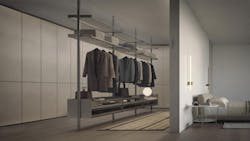Interior Designers and Fashion Directors Team Up to Find Sustainable Solutions
Fashion and architecture are intertwined in more ways than one, from a burgeoning focus on sustainability to a shared resourcefulness in new material development across brands in both disciplines. That’s why fashion directors and architects are joining forces to find timely solutions for more innovative and mindful design strategies.
Italian luxury furnishings and organizational solutions brand Rimadesio recently teamed up with award-winning interior designer Daun Curry and clothing designer Karolina Zmarlak to discuss the future of slow and sustainable design in fashion and residential construction. Their proposals highlight the creative similarities in both industries and offer a pathway toward sustainability suited for an evolving consumer base.
“A client’s closet is a great starting point for interior design inspiration and a great indicator of personal style, so I often start there. I’ll note things like, ‘Oh it seems like you wear a lot of leather,’ or, ‘you like chunky sweaters and bold jewelry.’ We get clues from their fashion sense and choices and start building a story,” says Daun Curry, who is known for layering a variety of colors, materials, textures, and patterns in her trademark designs.
Zenit Walk-In Closet at Rimadesio’s New York Flagship Showroom
Photo: Josh Wong Photography
Curry’s designs build upon the history and lifestyle of her clients, which is why she’s constantly looking for ways to stay ahead of new trends in the residential sector. As sustainability and health and wellness top the list of consumer demands post-pandemic, Curry is finding simple but effective ways to appeal to a new clientele.
“Embarking on an interior design and/or architecture project oftentimes feels overwhelming to clients, but I remind them they've been dressing themselves their whole life,” she says, “That element of taste and how we want to portray ourselves is in essence the same approach we take to how we design our interiors around how we want to live. So sometimes we start small (with the colors, patterns, textures and accessories they are drawn to wearing) and build from there.”
When it comes to forward-thinking design, Curry isn’t blazing a trail on her own. Instead, she’s joined by creative forces like Karolina Zmarlak, who bases her modern clothing designs on the concept of “l’art d’habiter,” or creating a functional space meant to be inhabited. Much like interior design trends, Zmarlak’s products focus on multifunctionality with pieces catered to a diverse consumer base.
“Our design discipline places a premium on multifunctionality. In a way that reflects it through the pieces being designed for fluidity of wear,” Zmarlak says. “This makes it easier to dress for different occasions, moods, and offers the option to play with one’s personal style.”
Also at the forefront of fashion and interior design is sustainability—which Curry, Zmarlak, and the creative thinkers at Rimadesio believe goes hand-in-hand with high quality product development. Not only are designers creating new and improved product lines made with more environmentally friendly materials, but they’re also implementing sustainable practices inside their factories and studios.
“Rimadesio is an environmentally conscious company that proves high design can go hand-in-hand with sustainable practices,” says Andrea Romano, North America Resident Manager at Rimadesio. “The entire line of production runs on recyclables and recyclable glass. Our factory runs on solar panels. They have more than 5,000 solar panels on a big solar farm in Italy that runs pretty much the entire company. They achieved zero emission of CO2 10 years ago and since then they have been working to catch up while they’ve grown over the past few years.”
Zenit Walk-In Closet
Photo: Rimadesio
Karolina Zmarlak is taking a similar approach to sustainable business practices by producing locally and using predominantly recycled materials at KZ_K Studio: “At our studio we adhere to slow fashion principles. We produce locally in the garment district and utilize advanced fabrics, which are recycled products. Our collection is also sourced only from specific European mills and Japanese mills due to their efforts to make sure that they are following sustainable practices,” she says.
Integral to a more eco-friendly design strategy is a shift away from fast fashion, which often prioritizes profit over quality and pushes sustainability to the backburner. According to Curry, more careful and intentional design reduces waste and leaves consumers with products that stand the test of time.
“I’m glad that there has been a growing movement to move away from fast fashion and fast furniture—design is not meant to be ‘fast,’” Curry says. “It should be thoughtful, timeless, and have longevity. That's the way to really appreciate its beauty and functionality.”


